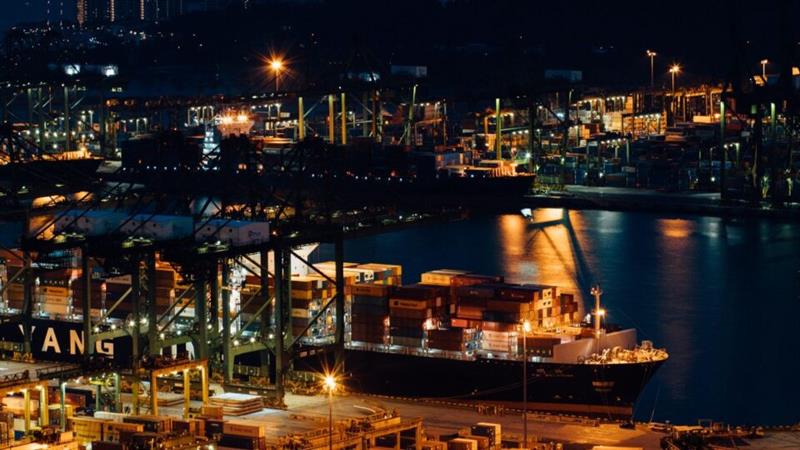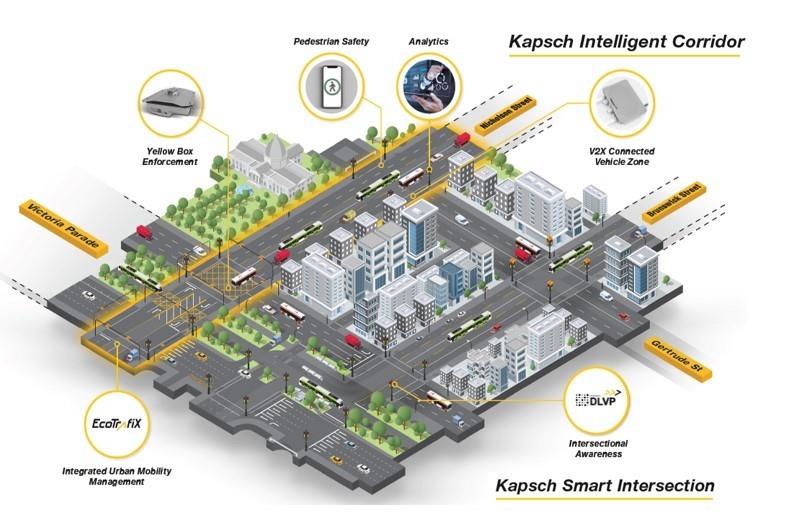However, there are myriad projects underway across the globe at various stages of maturity in all sectors that involve the transport of goods and people.
Here are just a few examples ranging from AI systems being used to speed up the loading and unloading of passengers and freight in ports to constructing infrastructure from more environmentally friendly materials with embedded sensors that could reduce costs massively across an entire county’s travel network.
Smart rail infrastructure
Rail is said to be one of the greenest ways to travel and transport goods but building infrastructure uses a significant amount of energy, known as ‘embedded carbon’.
For example, the cables that provide electricity to trains are supported by masts which are typically made from energy-intensive galvanised steel on steel pile foundations.
Engineering firm Furrer+Frey and composite materials manufacturer Prodrive are working with Cranfield University to develop a prototype composite overhead railway line mast with integrated smart sensors along with rail technology developers TruckTrain, and research teams from Southampton and Newcastle Universities.
It is hoped that significant energy and carbon savings will be made on each mast, which will add up considerably across the thousands of kilometres of electric railway in the UK.
Matt Bradney, director of business development at Prodrive Composites, says: “The composite ingredient for the masts is significantly lighter and stronger than steel by weight. We are aiming for a composite that has minimal, or even negative, embedded carbon.
“We hope this project will fuel further experimentation with composites in the rail industry to drive sustainable innovation forward.”
Noel Dolphin, head of UK projects for Furrer+Frey, adds: “To decarbonise transport, it is vital that we make a swift transition away from fossil fuels and roll out electrified trains. But it is also important that the infrastructure involved in this process is as green as possible.
“We’re excited to be partnering with experts from across our industry to crack one of the big problems facing UK rail – that of lower carbon and lower cost electrification works.”
The built-in sensors will provide data directly to infrastructure owners, enabling maintenance to be better targeted, reducing the need for line-side manual checks, which will also save fuel.
Cranfield will work with Newcastle University on the materials that will be used in the Innovative MAst for Greener Electrification (IMAGE) mast structure. Prodrive Composites will design the production method and Southampton University will work on the mast foundations. TruckTrain will be analysing the overall financial and carbon benefits of IMAGE.
The project aims to demonstrate IMAGE in early 2022, after which Furrer+Frey intend to roll out the masts across the UK and beyond.
Smart Ports
Port information management systems developer, Innovez One is supplying its AI powered MarineM digital platform to optimise Singapore-based passenger and equipment ferrying service provider, Cast Marine Offshore to optimise its operations and improve the efficiency of its 20-vessel fleet.
Slyvia Lim, director of Cast Marine Offshore states: “We believe in the potential of digital technologies to increase our efficiency and provide the best possible service to our clients. Embracing digital solutions will enable us to remain relevant and competitive as a service provider, now and in the future.”

Using GPS and AIS tracking MarineM is designed to keep track of each vessel’s position and the status of jobs in real-time. This will ensure that jobs are allocated as efficiently as possible and that any last-minute requests are managed seamlessly.
The software can also automate a number of operations by replacing paper-based billing procedures with electronic receipts and invoices for completed jobs, streamlining the accounting process. It will also reduce waiting times for passengers by issuing e-tickets, allowing them to access boarding information from their smartphones, check-in more easily and be informed of any last-minute changes instantly.
Innovez One CEO and founder David Yeo says: “As we have experienced in recent months, the first and the last mile of a journey at sea is often a weak link in global supply chains. Even small delays can lead to a domino effect which exacerbates port congestion.
“The adoption of digital solutions by the multiple actors involved will ensure that all pieces fall into place to welcome a ship when it arrives in a port and facilitate its swift departure when it is ready to leave.”
Smart Airports
Civil aviation is also undergoing rapid digital transformation which has raised a number of critical challenges. For example, converging the data of traditional siloed networks to support new services, and improving passengers' Wi-Fi experience in terminal buildings.
Furthermore, because of ‘service cloudification’, airports must address cyber-security defence concerns and, due to the ever-expanding network scale, they must also increase operations and maintenance efficiency.
To help solve these problems, Chinese technology company Huawei has launched its Airport Cloud-Network Solution which includes airport terminal access network, backbone network, cloud data centre network and integrated network security.
According to Huawei, the solution leverages AirEngine Wi-Fi 6 to create a gigabit wireless access network across airport terminal buildings for continuous coverage, eliminating blind spots and increasing coverage distance by 20%.
The Airport Cloud-Network Solution uses IPv6+ technology to build a centralised backbone network for multiple services such as security checks, retail and ground handling. It also supports automatic network deployment to speed up service provisioning and employs intelligent technologies to predict and locate faults.
Additionally, it provides a cloud-network-security collaboration system to detect threats with an accuracy of more than 96% and for intelligent analysis, offering real-time insights.
Huawei data communication product line vice-president, Alex Sun, says: “With continuous technological innovations on airport security, efficiency and experience, Huawei will continue to work with more customers and partners worldwide to advance the Airport Cloud-Network Solution, in turn boosting digital transformation for smart airports.”
Smart traffic solutions
When it comes to sustainable mobility in cities, avoiding congestion is key. Intelligent traffic management allows authorities to record and respond to traffic conditions in real time as well as having positive effects on the environment and quality of life.
“Traffic congestion and its associated emissions create a public health crisis and cause millions of dollars in lost productivity,” says Gerd Gröbminger, vice president, sales CENECA (Central Eastern Northern Europe & Central Asia) at Austrian-based Kapsch TrafficCom. “That’s why we are driving innovation and technology in key areas such as Connected Driving, Smart Roads and Smart Mobility Pricing. All these elements need to work together if we want to achieve sustainable change.”
One of its solutions, Green Wave Assistant, processes traffic signal timing data and sends it to a smartphone app or a vehicle’s navigation system so that drivers can see when traffic lights are set to go green so they can travel smoothly between them, reducing traffic jams and saving fuel/energy.

Another of its tools for combating traffic congestion is EcoTrafix, which optimises traffic signal timing, so traffic jams don’t form at intersections, potentially reducing congestion by up to 25%, according to Kapsch.
It also includes data exchange with navigation providers. By using deep learning algorithms, it is not only possible to determine optimal routing for traffic, but also to balance traffic according to local needs on all available routes.
One of the 50 plus projects currently underway in cities around the world, in which Kapsch is involved, is ‘Mobility Hub’ which covers over 100km of roads, more than 70 intersections and multiple types of transportation within the Australian Integrated Multimodal EcoSystem (AIMES) in Melbourne. Kapsch claims that this is the world’s first and largest connected urban testing ecosystem.







